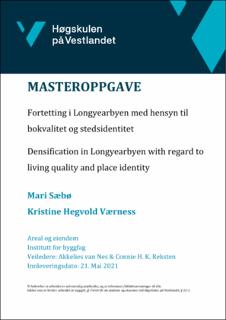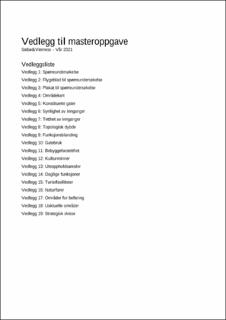| dc.contributor.author | Sæbø, Mari | |
| dc.contributor.author | Værness, Kristine Hegvold | |
| dc.date.accessioned | 2021-08-11T11:51:52Z | |
| dc.date.available | 2021-08-11T11:51:52Z | |
| dc.date.issued | 2021 | |
| dc.identifier.uri | https://hdl.handle.net/11250/2767374 | |
| dc.description | Masteroppgave i areal og eiendom.
Fakultet for ingeniør- og naturvitskap/ Institutt for byggfag/ Høgskulen på Vestlandet, campus Bergen. | en_US |
| dc.description.abstract | Longyearbyen er i en overgangsfase fra et lokalsamfunn basert på gruvevirksomhet til å bli et lokalsamfunn hvor turisme og forskning overtar som dominerende næringer. Byen har behov for en bærekraftig utvikling på grunn av naturfarene, utdaterte boliger, og en kostnadskrevende infrastruktur. En fortetting av Longyearbyen kan være en løsning på utfordringene byen står overfor, men står i fare for å bli møtt med motstand fra lokalbefolkningen på grunn av stedets sterke historie og identitet.
Denne oppgaven har som formål å danne et perspektiv på hvordan en fortetting kan gjennomføres i Longyearbyen, samt hvordan en fortetting vil kunne påvirke byen og innbyggerne. Dette blir gjort ved å se på det potensialet Longyearbyen har i dag, og ved å involvere innbyggerne for å belyse deres tanker og ønsker for byen.
For å avdekke dagens situasjon i Longyearbyen har det blitt gjennomført en rekke konfigurative og morfologiske stedsanalyser. Som en kvalitetssikring av gjennomførte stedsanalyser, og for å gi forfatterne en følelse av hvordan Longyearbyen er, ble det gjennomført befaring i studieområdet. For å kartlegge innbyggernes relasjon til og tanker om Longyearbyen, ble det gjennomført en spørreundersøkelse med et bredt utvalg av befolkningen.
Resultatene fra denne oppgaven viser at Longyearbyen har flere styrker og svakheter. Byen har et dårlig oppbygd gatenettverk som er dominert av biltrafikk. Det er mangel på uteoppholdsarealer og det er lav grad av funksjonsblanding i byen. Sjøfronten i Longyearbyen er også dårlig utnyttet. Byens identitet er sterkt knyttet til stedets historie i form av kulturminner, byggestil og naturen, noe innbyggerne syns er viktig å bevare. En fortetting av Longyearbyen bør gjennomføres med fokus på å utbedre gatenettet, etablere gode uteoppholdsområder og oppfordre til funksjonsblanding. Ny utvikling av byen burde gjennomføres på en måte som implementerer eksisterende byggestil og kulturhistoriske elementer med det nye, samtidig som man møter fremtidens behov for en bærekraftig byutvikling. | en_US |
| dc.description.abstract | Longyearbyen is in a transition phase from a local community based on mining activities to becoming a local community where tourism and research take over as dominant industries. The city needs a sustainable development due to natural hazards, outdated houses, and a costly infrastructure. A densification of Longyearbyen can be a solution to the challenges the city faces but is in danger of being met with opposition from the local population due to its strong history and identity of the place.
The purpose of this thesis is to form a perspective on how a densification can be carried out in Longyearbyen, as well as how a densification could affect the city and its inhabitants. This is done by looking at the potential of Longyearbyen today, and by involving the inhabitants to shed a light on their thoughts and desires for the city.
To uncover the current situation in Longyearbyen several configurative and morphological analyses have been carried out. As a quality assurance of the analyses, and to give the authors a sense of what Longyearbyen is like, an inspection was carried out in the study area. To map the inhabitants' relationship to and thoughts about Longyearbyen a survey was conducted with a wide sample of the population.
The results show that Longyearbyen has several strengths and weaknesses. The city has a poorly constructed street network that is dominated by car traffic. There is a shortage of outdoor living areas and there is a low degree of functional mix in the city. The seafront in Longyearbyen is also poorly utilized. The city's identity is strongly linked to the place's history in the form of cultural monuments, building style and nature, something the inhabitants think is important to preserve. Densification of Longyearbyen should be carried out with a focus on improving the street network, establishing good outdoor living areas, and encouraging a mix of functions. New development of the city should be carried out in a way that implements existing building style and cultural-historical elements with the new, while meeting the future needs for sustainable urban development. | en_US |
| dc.language.iso | nob | en_US |
| dc.publisher | Høgskulen på Vestlandet | en_US |
| dc.rights | Navngivelse 4.0 Internasjonal | * |
| dc.rights.uri | http://creativecommons.org/licenses/by/4.0/deed.no | * |
| dc.title | Fortetting i Longyearbyen med hensyn til bokvalitet og stedsidentitet | en_US |
| dc.title.alternative | Densification in Longyearbyen with regard to living quality and place identity | en_US |
| dc.type | Master thesis | en_US |
| dc.description.localcode | MOA300 | en_US |


